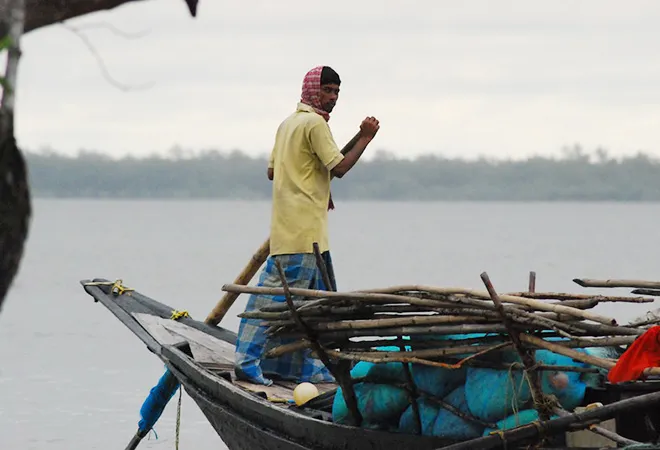 This article is part of the series — India–Bangladesh Relations @50: Commemorating Bilateral Ties.
This article is part of the series — India–Bangladesh Relations @50: Commemorating Bilateral Ties.
The Sundarbans ecoregion — located in the tidally active lower deltaic plain of the Ganges–Brahmaputra–Meghna (GBM) basin — hosts the largest contiguous mangrove forest and the only mangrove tiger habitat in the world. Spread over parts of Bangladesh and India, the Protected Areas (PA) within the forested parts are designated by the United Nations Educational, Scientific and Cultural Organisation (UNESCO) as World Heritage Sites in both countries. The natural areas ning ~10,000 square kilometres across the two countries are also Ramsar Sites or Wetlands of International Importance. The natural area was at least twice as large in the 1770s when the British East India Company and, subsequently, the British Government of India encouraged cultivation and settlement in the ecoregion to augment revenue. The cleared forest tracts in the two countries are now collectively home to over 7.5 million people.
Although the forest boundary has not undergone any significant changes since 1947, natural areas outside ‘Protected Areas’ are greatly influenced by direct human use. The ecoregion is increasingly threatened by climate–induced hazards (e.g., rising sea levels, intensifying storms, and changing salinity), and mounting anthropogenic pressure due to rising population and economic development. After recognising these threats, Bangladesh and India signed a Memorandum of Understanding (MoU) on the Conservation of the Sundarban in September 2011. Since then, significant progress has been made in joint assessment of the status of tigers. However, joint action in the form of defining the region for operationalising the MoU, developing a common and shared understanding of the impacts of climate change, and addressing issues of livelihood of the ecosystem–dependent population, amongst others, have seen little to no action. Given the rapidity of adverse change and the scale of challenges facing the region, this inaction is inexcusable. The 50th year of India–Bangladesh diplomatic relations is an opportune moment to revisit the MoU and reinvigorate joint action that is scale– and time–commensurate.
Joint action in the form of defining the region for operationalising the MoU, developing a common and shared understanding of the impacts of climate change, and addressing issues of livelihood of the ecosystem–dependent population, amongst others, have seen little to no action.
Given that the Sundarbans present an opportunity where joint or coordinated action does not put either country to disadvantage, a common understanding of the term ‘Sundarban’ could be the restarting point for Bangladesh and India. In India, the term Sundarban encompasses the forest area and the historically forested area, where people settled in during the colonial times, which has been designated as the Sundarban Biosphere Reserve since 1989. In Bangladesh, the term Sundarban implies the extant forest area only. A common and shared understanding of the term Sundarban will settle the geographical scope of the MoU, which is a necessary precondition for initiating the joint action envisaged in the MoU. Once it is defined and agreed, Bangladesh and India could emulate the historical administrative arrangement for effective action on conservation and sustainable development in the region.
In the colonial dispensation, the collectors of the then 24 Parganas, Jessore, and Bakarganj districts exercised concurrent jurisdiction with the local commissioner in revenue matters in the Sundarbans. Practically, it was the Sundarbans commissioner who performed the revenue work in parts of these districts and the revenue of all Sundarbans estates was paid into the respective collectorates. The office of commissioner of the Sundarbans was established under Regulation IX of 1816 to ascertain the extent of encroachment by the neighbouring landholders beyond their permanently settled lands, so as to bring the encroached land within the revenue–paying estates. The jurisdiction of the Sundarbans commissioner was enhanced in 1819 to grant leases of forestlands on behalf of the government but land revenue, as before, continued to be paid into the treasuries of the respective districts in the north. The office of the Sundarbans commissioner was dissolved in 1905, by which time mapping and resource inventory was more or less complete.
A common and shared understanding of the term Sundarban will settle the geographical scope of the MoU, which is a necessary precondition for initiating the joint action envisaged in the MoU.
Bangladesh and India should consider reviving the office of the Sundarbans commissioner with jurisdiction over the defined and agreed geographical area. This area could be designated as the transboundary Sundarban district or remain part of several districts as is the case now. To retain the primacy of the State, the Sundarban commissioner would: a) report to a suitably empowered Joint Working Group, b) would not exercise revenue and law and order jurisdiction over the region, and c) implement conservation and development action through respective government machinery. This would not only ensure time– and scale–commensurate interventions in the Sundarban region but also serve as a model for transboundary governance. Such is the potential of cooperation on the Sundarbans.
The views expressed above belong to the author(s). ORF research and analyses now available on Telegram! Click here to access our curated content — blogs, longforms and interviews.



 This article is part of the series —
This article is part of the series —  PREV
PREV


